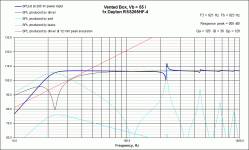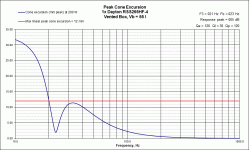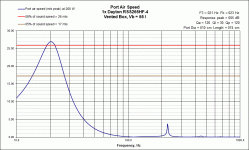I'm looking to build a subwoofer to go with my TM overnight sensations. I am primarily concerned about how my music sounds but will be using it for home theater as well. My budget is around $300 for all parts. I would prefer the sub be as small as possible.
I have modeled a few drivers but I'm beginning to realize that I'm not sure what response curve would be ideal for music (I've read flat).
I have modeled a Dayton Audio RSS265HF-4 in a 55 liter ported enclosure and tuned it to 23 Hz using a 4 inch pvc pipe. I've attached the response curve, extension and port velocity.
Is this curve an acceptable looking curve?
Would a Dayton Audio SPA250 250 Watt Subwoofer Plate Amplifier be an acceptable amp?
Is the port velocity acceptable?
I have modeled a few drivers but I'm beginning to realize that I'm not sure what response curve would be ideal for music (I've read flat).
I have modeled a Dayton Audio RSS265HF-4 in a 55 liter ported enclosure and tuned it to 23 Hz using a 4 inch pvc pipe. I've attached the response curve, extension and port velocity.
Is this curve an acceptable looking curve?
Would a Dayton Audio SPA250 250 Watt Subwoofer Plate Amplifier be an acceptable amp?
Is the port velocity acceptable?
Attachments
Flat response is a good thing to shoot for, though room position, size, openings will change the response considerably.Is this curve an acceptable looking curve?
Would a Dayton Audio SPA250 250 Watt Subwoofer Plate Amplifier be an acceptable amp?
Is the port velocity acceptable?
The port velocity looks good, with a 3/4" roundover there should be no chuffing (port noise) unless driven hard below Fb.
Although the amp is capable of driving the speaker to Xmax, I'd probably want to get something with more headroom, like in the 400-500 watt range.
Although I have no experience with how the SPA250 sounds when clipped, clipping most amps sounds far worse than a bit of speaker flapping.
That said, if you think 106 dB at one meter is enough level, no need to get more power.
Kudos to Dayton/Parts Express, but actually I found Guitar Center had insane $/watt on pro amps (unless you want to integrate a plate for space or aesthetic reasons).
A subwoofer should really NOT be "as small as possible." Trying to achieve that runs into a litany of sins:
- Small diameter drivers
- Small box meaning the bass doesn't go low OR super low efficiency
- Porting becomes stupid, because a big enough port becomes bigger than the box (and with small drivers you need a port to get enough output to even hear the lows).
Can these be overcome? Yes, to a degree. It's called "engineering challenges" ha ha.
But each extra cubic foot you allow yourself will yield a lot more design freedom and better results.
As for the response, I prefer a kind of drooping, more extended bass. This to me equates to a tighter sound, and matches room gain better. You could lengthen the port a bit (if you have room) &/or stuff the cabinets (which you should anyway).
A subwoofer should really NOT be "as small as possible." Trying to achieve that runs into a litany of sins:
- Small diameter drivers
- Small box meaning the bass doesn't go low OR super low efficiency
- Porting becomes stupid, because a big enough port becomes bigger than the box (and with small drivers you need a port to get enough output to even hear the lows).
Can these be overcome? Yes, to a degree. It's called "engineering challenges" ha ha.
But each extra cubic foot you allow yourself will yield a lot more design freedom and better results.
As for the response, I prefer a kind of drooping, more extended bass. This to me equates to a tighter sound, and matches room gain better. You could lengthen the port a bit (if you have room) &/or stuff the cabinets (which you should anyway).
- Status
- This old topic is closed. If you want to reopen this topic, contact a moderator using the "Report Post" button.


